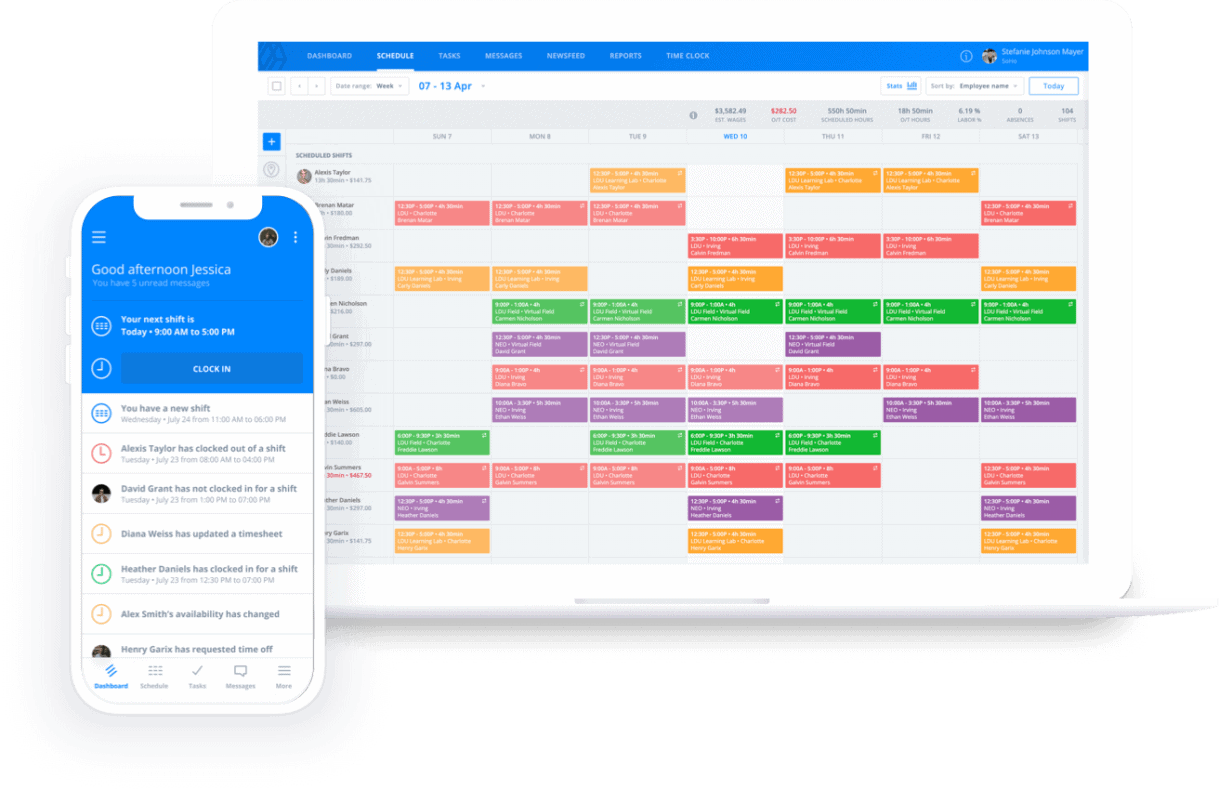5 Employee Training Methods And How To Implement Them
At first glance, you may think that employee training is all about teaching your...

A team is like a family. Sure, your team isn’t related by blood, but it benefits from many of the traits that make families strong: camaraderie, cooperation, and strong bonds. Increasing employee engagement will help you build those traits and attract and retain the best talent.
Without engaged employees, your team can suffer from poor performance, lack of motivation, and high turnover.
In this article, we give you 30 employee engagement ideas you can use to make your employees more motivated and productive.

At its core, employee engagement is the ability of your team members to be present in the moment, focused on the task at hand, and energized about achieving good results.
This feeling motivates your employees to go above and beyond what you expect of them because they feel that they have a higher purpose — be it for the success of your business or the betterment of your clients and customers.
It’s that purpose that is a cornerstone of strong, effective, and long-lasting employee engagement.

As we mentioned above, employee engagement is a sense of purpose inherent in everything your team does.
That may sound like a simple idea, but employee engagement done right has far-reaching effects on every corner of your business — from improved profit margins to more powerful branding. Put simply, employee engagement is vital for your business and its success.
But more than that, employee engagement matters to your employees. For that reason alone, it should matter to you.
When you show your team that you care about them as individuals, not just as cogs in the machine, they will get excited about and invested in making your business a success.
If you this sounds like it adds a lot of work to your already-full plate, start small with one or two employee engagement ideas from the list below. When those have become habit, implement one or two more until your employee engagement is higher than it’s ever been.

Make yourself approachable by having an open-door policy during scheduled times. Employees will be more willing to approach you with questions, suggestions, and problems if they know they’re not interrupting your busy schedule.
Open office hours improves employee engagement because your team will begin to see you as a member of the team who works with them to get things done rather than just as their manager.
Games of any kind are a great way to forge bonds and build camaraderie.
Take time out to play a few rounds of Pictionary or Trivial Pursuit. Set up a TV and a Nintendo 64 and play Mario Kart. If you want to get outside the office for an hour, organize a game of kickball.
A frustration box, or complaint box, is the opposite of a suggestion box. If you adhere to a strict anonymity policy, employees will feel free to vent their concerns.
As a manager, you can get some deep insights into the problems your employees face. And sometimes, those problems make a solution more obvious than a suggestion ever could.
Whether it’s every week or once a month, get your staff together and hold a brainstorming session about employee engagement ideas.
You can also bring a problem (something from the frustration box?) and let your employees throw out ideas for solutions. This will bring your team in alignment with your strategy and help them realize they’re making an impact.
Put up a whiteboard or corkboard in a common area and post a question.
The question could be a problem looking for serious answers. It could be a joke looking for humorous answers. It could be a puzzle looking for the best solution. Encourage employees to answer it. And don’t restrict input to serious answers only!
Once a month, allow employees the opportunity to work with a different team or in a different role. This helps build empathy throughout the company.
Employees in one department know what challenges the other employees face on a daily basis. It also gives employees a change of pace from their daily routines.
Adhering to the maxim that the customer is always right is a great way to get employees to serve better. The thing is, the customer is certainly not ALWAYS right and he may need to hear the word no occasionally.
Yes, customers are important, but always placing them above your employees can lead to low engagement and morale. Always have your employee’s back if a customer wants too much.

Every company needs a clear hierarchy of responsibility. If an employee has to get approval from a superior, she should know who that person is.
What’s more, the hierarchy should be set and not constantly shifting from one manager to the other. This makes everything clear to the employee and doesn’t create confusion about which manager to approach for each problem.
Nothing will lower engagement and morale faster than being tossed into the workflow without proper training.
Establish a training process that is both comprehensive and personalized. And even though you’re busy, make sure the employee continues gets all the training they need to keep moving forward.
Many employees need clear guidance. A lack of guidance can lead to confusion and a lack of engagement.
These guidelines — usually in the form of an employee handbook — should state the expectations each employee will be held accountable for and outline behavior and other office norms.
By doing this, you give your employees a clear path to success because they understand what is expected of them and how they will be evaluated
Your employees can be your best source of innovation because they are intimately familiar with the processes under which they work.
Allowing employees to innovate, and then implementing those solutions, keeps your employees looking for better ways to get things done. This benefits you, your team, and the business as a whole by creating constant improvement.
Encourage innovation by recognizing and rewarding those who do so.
Hiring from within is a great way to keep employees motivated and engaged. It gives everyone in the organization a sense that moving up within the company is possible and generates excitement at the prospect.
It can also benefit the business as a whole because an inside employee is already experienced in how the company operates.
Employees need to know that they aren’t just showing up every day and putting in their time for no good reason. They need to feel part of something larger.
Show each employee how their job contributes to, or benefits, the company vision. This gives them a sense of belonging. It also shows them that their daily routine is contributing to a larger goal.
Strong leadership is critical to achieving an engaged team.
It gives employees the confidence that their boss knows what she’s doing. It helps them feel valued. It helps them feel part of a team. Improve your leadership skills by listening more and by expressing trust in your team.
Working on yourself first can go a long way toward improving the engagement of those around you.
Building pride in the company motivates the employees to see their company as a responsible, caring group of people that is doing good in the community.
You can build pride by telling your employees about the good that the company is doing. Next time you get a major compliment from a local customer, let your team know about it at the next meeting.
 There’s nothing more frustrating than not having the resources to do your job effectively. So, make sure your employees do have those resources!
There’s nothing more frustrating than not having the resources to do your job effectively. So, make sure your employees do have those resources!
It could be something as simple as providing more training or something as complicated as updating the technology they use on a daily basis.
Improving employee engagement can be as simple as defining your company’s purpose.
This purpose, then, shifts the focus from the WHAT and the HOW of your company, to more firmly illuminate WHY your company does what it does.
This purpose gives your employees something bigger to look at than just the process or the product that they work with every day.
Disagreements and arguments amongst company leadership should be kept away from the eyes and ears of the employees.
Management should always convey a united front. This means taking disputes behind closed doors or waiting until after hours to address the problem.
On a ship, the first officer may disagree with the captain’s decision but he would never say so in front of the crew. Doing so would undermine the captain’s authority and make the running of the ship more difficult.
Instead, the first officer would pull the captain aside and then make his concerns known in private. The same goes for a business.
If all your employees do is work, eat, and sleep without having a life outside of the company, they’re going to be more stressed and burn out quicker. Their work may also become less efficient and of lower quality.
To avoid this, consider instituting a flexible work schedule or giving employees time off when they’re fatigued. If your employees have a happy life outside of work, they’ll be more productive.
 Work can become routine and uninspiring when the same things are done over and over every day.
Work can become routine and uninspiring when the same things are done over and over every day.
To remedy this, give your employees “stretch assignments” that allow them to step outside their comfort zone, try something new, and give them a challenge to conquer.
This could be leading a team meeting or heading up a new project. Whatever it is, it should push the employee and not just be a rehashing of what they normally do.
Instead of just looking at skills, think instead about how a prospective employee would fit into the company culture.
Though they may have all the qualifications necessary to do the job right, if their attitude doesn’t mesh with company values, they’ll be less engaged and may cause disruptions in other employee’s engagement.
Sometimes there can be a divide between upper management and employees. This can be a perceived divide that isn’t real or it can be an actual divide that needs to be bridged.
Have members of upper management lead team meetings on occasion. Or, have them hold open office hours to get better acquainted with the employees.
This may sound strange, but a company blog can help break the wall that always seems to exist between management and employees.
Encourage the staff to read and comment on the blog. Doing so can help the staff to feel like they are a part of something bigger. It can also help make management more familiar and give them a more human presence.
 Work is important, but sometimes, getting out of the office is equally as important.
Work is important, but sometimes, getting out of the office is equally as important.
Consider organizing an office outing to break the routine and give your team the opportunity to get to know each other.
Paintball or Laser Tag make for a fun team-building exercise and can be a great way to burn off some of the office stress.
 The simple act of eating together can have profound effects on your employees’ engagement.
The simple act of eating together can have profound effects on your employees’ engagement.
Consider gathering together once a week for a group meal. You could have food brought in, make it yourself if you run a restaurant or have everyone contribute a dish. If you’d like to get out of the office, go to a nearby pub.
Without adequate compensation, no amount of games or perks or activities will make an employee feel engaged.
You can tell your employees that they are valuable and perform well until you are blue in the face. But without the money to back up what you’re saying, they may take it as nothing but hot air.
Training above and beyond what they receive when they are hired can go a long way toward keeping an employee engaged.
It can keep their mind active and make them feel like they are making progress rather than being stuck in a rut. Try to make training fun, too.

Business is becoming more global every day. Hiring with diversity in mind gives you access to those markets like never before.
Diversity also empowers your team to feel like they have the tools necessary to broaden their horizons and push your business into new territory.
Excitement at encountering new challenges and setting new goals can have a hugely positive impact on employee engagement and the way your team works together.
Don’t view onboarding as something you need to get through before you can get back to your “real” work. Instead, view it as a path to success — for your team and your business — and one of the most effective employee engagement ideas.
When you put the same importance on your onboarding process as you do on your strategy implementation plan or your project plan, you’ll start to see improvements in the way your employees work. That will translate into the improvement of your business overall.
For more on perfecting your onboarding process, take a moment to read these helpful resources:
Cohesion, cooperation, and unity are at the heart of all great teams.
When your business feels like a team working toward a common goal rather than individuals just trying to get stuff done, employee engagement will skyrocket.
That, in turn, will manifest as an improved work environment, better interpersonal relationships, a higher standard of customer service, and a more enjoyable and productive business culture.

At the most basic, employee engagement depends a great deal on communication.
It doesn’t matter if that communication revolves around scheduling, inventory, clocking in and out, ethics, or customer service. The better you communicate with your employees the more engaged they’ll be.
We developed the Sling app to streamline communication and make your work life easier.
Sling is a suite of tools that makes scheduling, tracking labor, finding substitutes, assigning tasks, and building employee engagement extremely simple. And that’s just the tip of the iceberg.
For an all-in-one solution to help you improve your workforce management and implement these employee engagement ideas, incorporate the Sling suite of tools into your workflow.
Features include:

Add to that Sling’s onboard artificial intelligence and you’ve got an extremely beneficial and flexible set of tools that will help you get control of your team, increase engagement, and improve the way they work.
There are so many ways Sling can help improve your business that we don’t have room to talk about them here. So instead of reading about it, why not try it out? Sign up for a free account and see for yourself how Sling makes work better.
For more free resources to help you manage your business better, organize and schedule your team, and track and calculate labor costs, visit GetSling.com today.
See Here For Last Updated Dates: Link
This content is for informational purposes and is not intended as legal, tax, HR, or any other professional advice. Please contact an attorney or other professional for specific advice.
Schedule faster, communicate better, get things done.